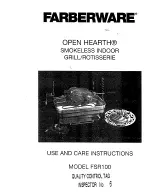
Use and maintenance manual HR EVO Smart
Pag.16
Rev.1 08/09/2021
EN
Characteristics of the fuel
Wood pellet is a fuel made of pressed wood sawdust, often recovered from processing scraps of carpentries. The material used
cannot contain any extraneous substance such as, for example, glue, lacquer or synthetic substances.
The sawdust, once it has been dried and cleaned from impurities, is pressed using a die with holes: as a result of high pressure, the
sawdust heats up by activating the natural wood binders; this way the pellet maintains its shape even without adding artificial
substances.
Wood pellet density varies based on the type of wood and can exceed that of natural wood by 1.5 - 2 times.
The cylinders have a diameter of 6 mm and a variable length between 10 and 40 mm.
Their density is equal to approximately 650 kg/m
3
. Due to their low water content (< 10%) they have a high energy content.
The UNI EN ISO 17225-2:2014 standard (that replaces the EN PLUS standard) defines pellet quality by specifying three classes: A1,
A2 and B. Maintain fuels and other flammables at a suitable distance.
Ravelli recommends using wood pellet classified A1 and A2 according to the EN ISO 17225-2:2014 standard, or certified DIN PLUS
(more restrictive than the A1 class) or ONORM M 7135. Pellet may be light or dark coloured, it is normally bagged into bags that show
the name of the producer, the main characteristics and classification according to standards.
📌
Pellets must be transported and stored in a dry area. Upon contact with humidity they swell and become unusable
📌
It is therefore necessary to protect them from humidity, both during transport and during storage.
Non-permitted fuels
We recommend not using the following materials as fuel:
•
wood
•
treated wood (painted, lacquered, glued wood etc.);
•
sawdust or chips
•
liquid fuel
•
coal or other fossil fuels
•
plastic and derivatives
•
treated paper and cardboard
•
waste
•
fuels that release toxic or polluting substances
Using these fuels, on top of being forbidden due to the emission of polluting and harmful substances, causes the appliance to
deteriorate more rapidly and debris to accumulate in the appliance and in the smoke evacuation system, thereby reducing performance
and safety.
📌
The gases produced by these fuels are dangerous for the environment and for your health!
📌
Using fuel that is not compliant with the above will void the warranty.
Summary of Contents for HR EVO 200 SMART
Page 3: ......
Page 8: ......
Page 9: ......
Page 57: ...Manuale uso e manutenzione HR EVO Smart Pag 56 Rev 1 08 09 2021 IT 5 6 7 8 4 x4 x4 x10 x2...
Page 62: ......
Page 63: ......
Page 116: ......
Page 118: ...USE AND MAINTENANCE MANUAL HR EVO 200 SMART HR EVO 250 SMART...
Page 119: ......
Page 123: ......
Page 171: ...Use and maintenance manual HR EVO Smart Pag 54 Rev 1 08 09 2021 EN 5 6 7 8 4 x4 x4 x10 x2...
Page 176: ......
Page 178: ...BEDIENUNGS UND WARTUNGSHANDBUCH HR EVO 200 SMART HR EVO 250 SMART...
Page 179: ......
Page 183: ......
Page 231: ...Bedienungs und Wartungshandbuch HR EVO Smart Pag 54 Rev 1 08 09 2021 DE 5 6 7 8 4 x4 x4 x10 x2...
Page 236: ......
Page 238: ...MANUAL DE USO Y MANTENIMIENTO HR EVO 200 SMART HR EVO 250 SMART...
Page 239: ......
Page 243: ......
Page 291: ...Manual de uso y mantenimiento HR EVO Smart Pag 54 Rev 1 08 09 2021 ES 5 6 7 8 4 x4 x4 x10 x2...
Page 296: ......
Page 298: ...HANDLEIDING VOOR GEBRUIK EN ONDERHOUD HR EVO 200 SMART HR EVO 250 SMART...
Page 299: ......
Page 303: ......
Page 356: ......
















































